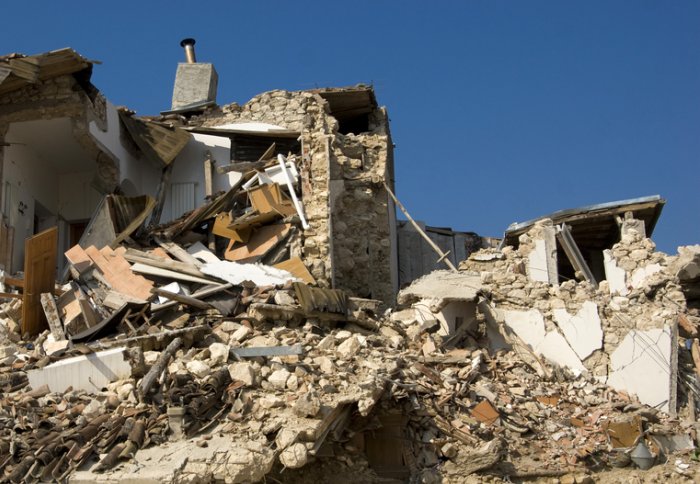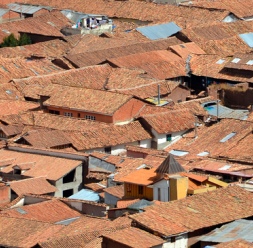
Imperial researchers are helping to design better homes for people in Latin America

Engineering 'quake-proof' homes could save lives, say Imperial College London academics.

Heavier clay tiles make bahareque more prone to collapse in earthquakes
They are developing new techniques that enable people in rural communities in Central and South America to build their own earthquake resistant, low-cost housing.
Since 1980, 18,300 people worldwide have died in homes that have collapsed because they were not engineered to be earthquake-proof.
Researchers at Imperial are developing techniques for improving traditional construction methods used by people in rural communities in Latin America, so that they are more able to withstand earthquakes. The aim of the project is to show people how they can build homes more robustly while still using traditional materials in a sustainable and low cost way.
The traditional style of home in the region consists of timber or bamboo frames that are clad in a lattice-work of cane, twigs and timber strips. These walls are plastered over with mud or mortar. Historically the roof is constructed from palm fronds, but after the Spanish conquest of the Americas in the fifteenth century, people switched to cooler, yet heavier roof tiles.
If properly constructed, these types of single-storey homes called ‘bahareque’ in El Salvador, ‘quincha’ in Peru, ‘cuje’ in Cuba and ‘pao pique’ in Brazil can have a high resistance to earthquakes. However, there are potential problems with bahareque because in most instances they are built by unskilled laborers who may use poor construction methods to save on costs. When this is combined with little maintenance, which can lead to rising damp or invasion from insects that can weaken the structure, these homes can collapse more easily in an earthquake.
Dr Christian Málaga Chuquitaype, from the Department of Civil and Environmental Engineering, who is one of the lead researchers on this project, is very familiar with this type of construction method in his home country of Peru.
He says: “People in rural communities in Central and South America can’t afford the latest materials and some are too poor to hire builders to construct their homes. They often live a subsistence life and have to take time away from their farming to build homes from the materials that are available to them. These unskilled laborers have a poor grasp of the engineering behind their homes and when this is combined with poor maintenance and inappropriate construction methods, these places are a prone to collapse in an earthquake. We hope our research will lead to the construction of robust, sustainable low cost homes.”
The team carried out experiments in the lab using traditional construction materials to build walls. They placed these walls in a device that can simulate earthquake conditions. This enabled the team to determine the best ways of keeping the structure from collapsing.
The new engineering techniques developed by the team include a lightly reinforced flat slab foundation. On top of the slab would sit two layers of reinforced hollow bricks that would form the base of the wall, which would be covered by damp-proofing to protect the home from moisture and insects. Timber, reinforced with a lattice-work of treated bamboo, would form the wall frames and galvanised chicken mesh would also be attached, enabling cement render to cling on to the frame. This style of wall building, say the researchers, would prevent it from crumbling apart into debris in the event of an earthquake.
The team also suggest doing away with the heavy clay roof tiles and replacing them with a lightweight corrugated cement-fibreboard roof. This would reduce the load of the roof and prevent it from collapsing.
This research stems from a ten-year student-led project in the Department of Civil and Environmental Engineering. Students have been travelling to Central and South America, working with rural communities to develop demonstrator homes that show people how to build more robust dwellings. It is called The El Salvador Project and it has also spawned a charity called Engage for Development, which was set up by alumni from the Department, and the charity facilitates similar student projects in developing countries.
The student project has also led industry to develop other methods for earthquake-proofing homes in rural communities. Sebastian Kaminski graduated from the Department in 2007 and started his career at the international consulting firm ARUP where he has been working on structural design in many projects worldwide. He is also a director in Engage for Development and maintains a strong link with Imperial.
Professor Ahmed Elghazouli, Department of Civil and Environmental Engineering, who is the principal investigator of the current research project on the seismic performance of low cost housing, in collaboration with ARUP and the Institution of Civil Engineers, says:
“It is great to see how a long-term student-led project can lead to a range of projects in industry and academia. Ultimately, this collective effort demonstrates how simple engineering principles could potentially be employed to help to save lives in communities.”
Article text (excluding photos or graphics) available under an Attribution-NonCommercial-ShareAlike Creative Commons license.
Photos and graphics subject to third party copyright used with permission or © Imperial College London.
Reporter
Colin Smith
Communications and Public Affairs

Contact details
Email: press.office@imperial.ac.uk
Show all stories by this author


